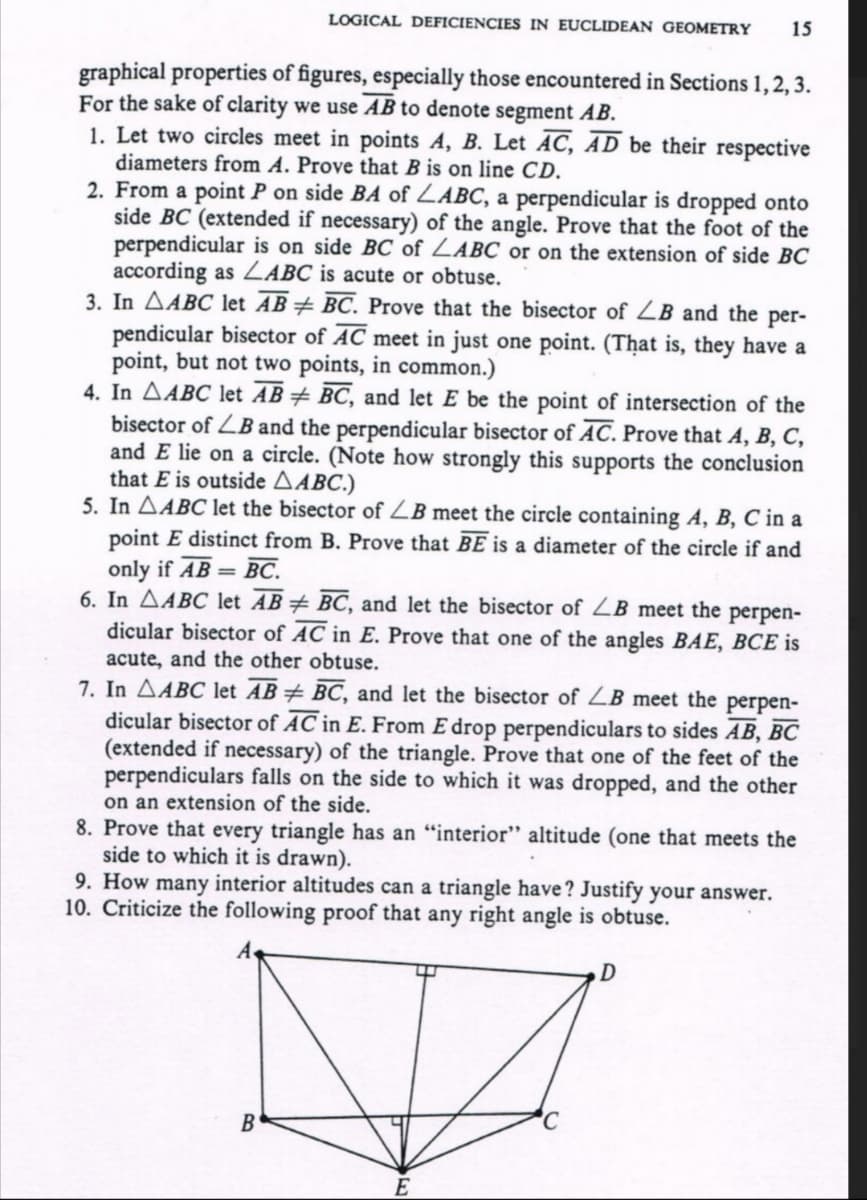Elementary Geometry For College Students, 7e
7th Edition
ISBN:9781337614085
Author:Alexander, Daniel C.; Koeberlein, Geralyn M.
Publisher:Alexander, Daniel C.; Koeberlein, Geralyn M.
Chapter4: Quadrilaterals
Section4.CT: Test
Problem 15CT: Complete the proof of the following theorem: In a kite, one pair of opposite angles are congruent....
Related questions
Topic Video
Question
Q10

Transcribed Image Text:LOGICAL DEFICIENCIES IN EUCLIDEAN GEOMETRY
15
graphical properties of figures, especially those encountered in Sections 1,2, 3.
For the sake of clarity we use AB to denote segment AB.
1. Let two circles meet in points A, B. Let AC, ĀD be their respective
diameters from A. Prove that B is on line CD.
2. From a point P on side BA of ZABC, a perpendicular is dropped onto
side BC (extended if necessary) of the angle. Prove that the foot of the
perpendicular is on side BC of ZABC or on the extension of side BC
according as LABC is acute or obtuse.
3. In AABC let AB÷ BC. Prove that the bisector of ZB and the per-
pendicular bisector of AC meet in just one point. (That is, they have a
point, but not two points, in common.)
4. In AABC let AB÷ BC, and let E be the point of intersection of the
bisector of ZB and the perpendicular bisector of AC. Prove that A, B, C,
and E lie on a circle. (Note how strongly this supports the conclusion
that E is outside AABC.)
5. In AABC let the bisector of ZB meet the circle containing A, B, C in a
point E distinct from B. Prove that BE is a diameter of the circle if and
only if AB = BC.
6. In AABC let AB# BC, and let the bisector of ZB meet the perpen-
dicular bisector of AC in E. Prove that one of the angles BAE, BCE is
acute, and the other obtuse.
7. In AABC let AB+ BC, and let the bisector of ZB meet the perpen-
dicular bisector of AC in E. From E drop perpendiculars to sides AB, BC
(extended if necessary) of the triangle. Prove that one of the feet of the
perpendiculars falls on the side to which it was dropped, and the other
on an extension of the side.
8. Prove that every triangle has an "interior" altitude (one that meets the
side to which it is drawn).
9. How many interior altitudes can a triangle have? Justify your answer.
10. Criticize the following proof that any right angle is obtuse.
B
E
Expert Solution
This question has been solved!
Explore an expertly crafted, step-by-step solution for a thorough understanding of key concepts.
Step by step
Solved in 6 steps with 1 images

Knowledge Booster
Learn more about
Need a deep-dive on the concept behind this application? Look no further. Learn more about this topic, calculus and related others by exploring similar questions and additional content below.Recommended textbooks for you

Elementary Geometry For College Students, 7e
Geometry
ISBN:
9781337614085
Author:
Alexander, Daniel C.; Koeberlein, Geralyn M.
Publisher:
Cengage,

Elementary Geometry for College Students
Geometry
ISBN:
9781285195698
Author:
Daniel C. Alexander, Geralyn M. Koeberlein
Publisher:
Cengage Learning

Holt Mcdougal Larson Pre-algebra: Student Edition…
Algebra
ISBN:
9780547587776
Author:
HOLT MCDOUGAL
Publisher:
HOLT MCDOUGAL

Elementary Geometry For College Students, 7e
Geometry
ISBN:
9781337614085
Author:
Alexander, Daniel C.; Koeberlein, Geralyn M.
Publisher:
Cengage,

Elementary Geometry for College Students
Geometry
ISBN:
9781285195698
Author:
Daniel C. Alexander, Geralyn M. Koeberlein
Publisher:
Cengage Learning

Holt Mcdougal Larson Pre-algebra: Student Edition…
Algebra
ISBN:
9780547587776
Author:
HOLT MCDOUGAL
Publisher:
HOLT MCDOUGAL

Algebra & Trigonometry with Analytic Geometry
Algebra
ISBN:
9781133382119
Author:
Swokowski
Publisher:
Cengage

Linear Algebra: A Modern Introduction
Algebra
ISBN:
9781285463247
Author:
David Poole
Publisher:
Cengage Learning